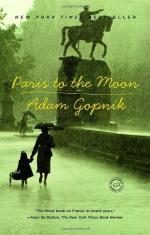|
This section contains 516 words (approx. 2 pages at 400 words per page) |

|
Paris to the Moon Summary & Study Guide Description
Paris to the Moon Summary & Study Guide includes comprehensive information and analysis to help you understand the book. This study guide contains the following sections:
This detailed literature summary also contains Topics for Discussion and a Free Quiz on Paris to the Moon by Adam Gopnik.
Paris to the Moon, by Adam Gopnik, was an account of five years spent by the author and his family in Paris, from 1995 to 2000. Gopnik, a writer for The New Yorker, arguably America's best magazine, fulfilled a lifelong desire to live in Paris. In so doing, he also continued a venerable tradition of correspondents to The New Yorker based in the French city. Much of the material in this book originally appeared as articles in the magazine. Gopnik's wife, Martha, and their young son, Luke, were the other most important people in the book.
As a chronicle of an American family adjusting to life in a European society, Paris to the Moon belongs to a genre of writing that goes back centuries, to when America was a brash upstart on the "other side of the pond" from the socially and culturally mature Old Europe. Paris, in particular, has long held a fascination for American writers, as a city of beauty, romance, and cultural achievement rarely matched in the world. The book's title came from an engraving Adam and Martha bought there, which showed a train on a track rising from Paris to the moon—an image Gopnik equated with a widespread perception of Paris as a celestial place. He related that he had first visited there for a year when he was a teenager and his parents, both professors, came for a sabbatical. Later, he and Martha "ran away" for a short while to Paris before they were married.
Luke was an infant when they arrived. He learned English and French simultaneously for the first five years of his life, and considered Paris home. Providing this experience for the child was a principle reason for the family going to France, and Gopnik expended many words on chronicling Luke's development. He also was very interested in French cuisine, both for itself and for what it revealed about the French way of life. He diligently shopped for the ingredients of meals, cooked, ate out a lot, tried to help protect a famous French restaurant from changes under new ownership, and discussed French food and its cultural importance with several experts.
Gopnik considered how he should think about the differences between French and American society, the importance of language, what he should choose to write about, and what such writing by an expatriate visitor could or could not achieve. He was fascinated with cultural differences concerning sports, and he examined other aspects of popular culture such as high fashion and the impact of US television on France. One of his most penetrating ideas, which recurred with embellishments throughout the book, concerned the impact on French society of an arrogant, rules-oriented public bureaucracy, and how everyday people coped by thinking of themselves and their lives in an abstract way that gave them distance and philosophical acceptance of their lot. Gopnik tried hard to understand this central attribute of the French mind while at the same time nurturing an acceptance of its mystery, just as he accepted and relished his main theme, the romance of Paris.
Read more from the Study Guide
|
This section contains 516 words (approx. 2 pages at 400 words per page) |

|



